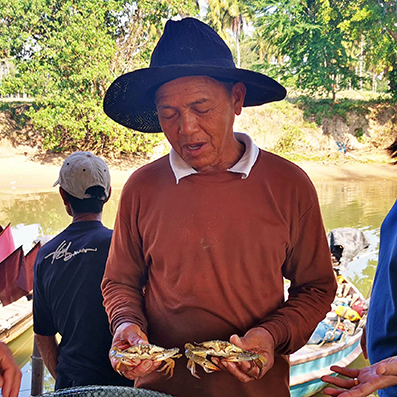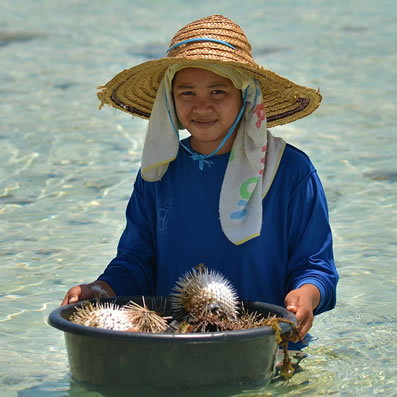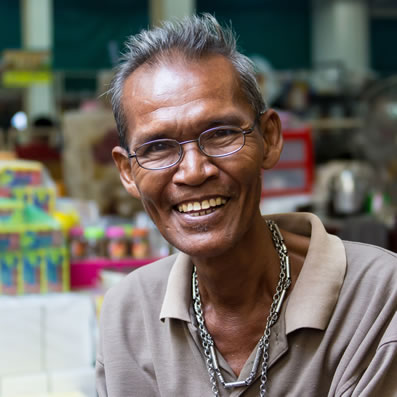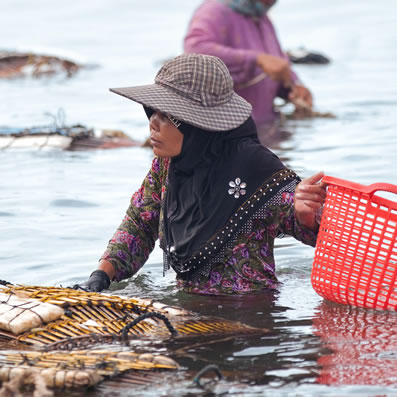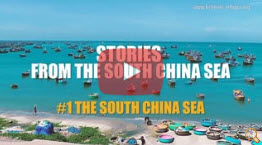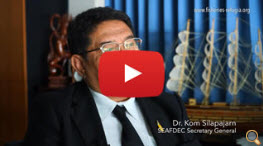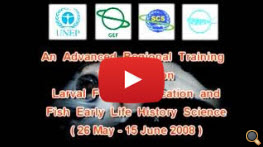THE SOUTH CHINA SEA FISHERIES REFUGIA INITIATIVE
FISHERIES REFUGIA PROJECT SITES
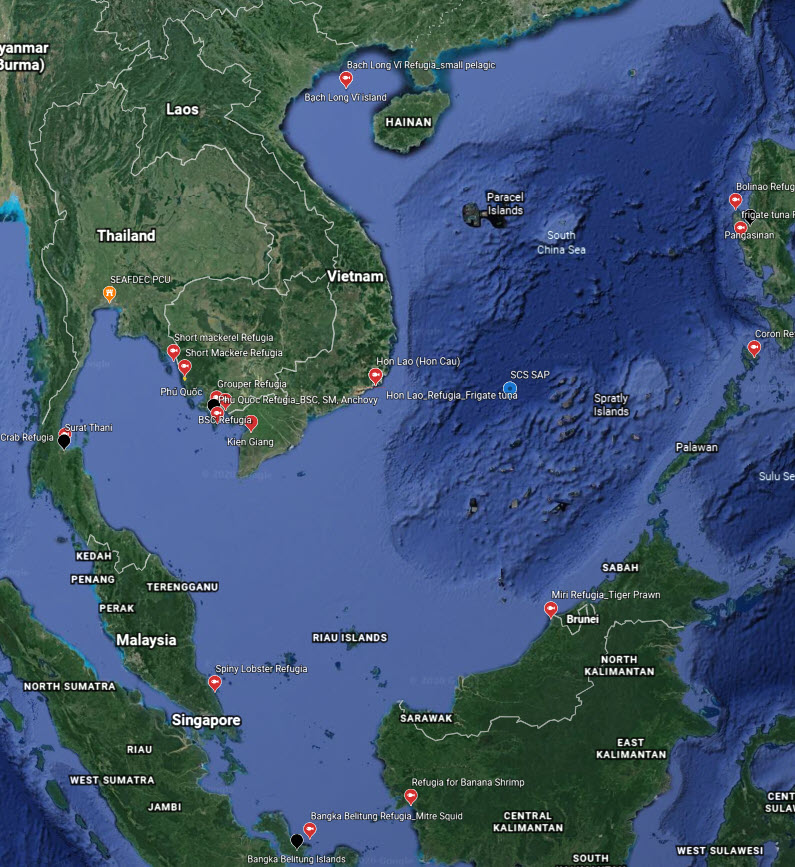 Click Here for
Click Here for More
Information
SCS SAP PRIORITY SITES (Habitat Linkages)
 All SCS SAP and
All SCS SAP and Fisheries Refugia
Priority Sites CHINA HABITAT
SITES CAMBODIA HABITAT
SITES INDONESIA HABITAT
SITES PHILIPPINES HABITAT
SITES THAILAND HABITAT
SITES VIET NAM HABITAT
SITES
Meet our Stakeholders
Social Media
Social Media
Changing Attitudes to Spark Action Towards Restoration of Blue Swimming Crab in Thailand
GEF-UNEP/SEAFDEC Fisheries Refugia Project

The South China Sea and the Gulf of Thailand contribute to high fisheries production, making many countries in the region among the top ten highest producers of fish in the world. It should note that fisheries are an important sector that creates a million jobs in the fisheries industry, produces seafood to the world market, helps a growing country economy, and improves livelihoods of people involved in fisheries. However, it is a fact that the perceived lack of responsible fishing practices and the resultant capture of vast quantities and diversity of non-target species significant effect on the ecosystem. Besides, overfishing threatens fish stocks regionally, reduces biodiversity, alters the ecosystem functioning, and jeopardizes the food security and livelihoods of people. The following describes how one can support healthy oceans by increasing the Blue Swimming Crabs stock changing fishermen attitudes towards responsible fisheries and ecosystem-based approach and usage of social media for effective communication. Even though it addresses one facet of the problematic, it impacts the world oceans is truly transformational; hence we would like to share with the world oceans community on the crucial "WORLD OCEANS DAY."
Why Fisheries Refugia for Blue Swimming Crab?
Blue swimming crabs (BSC) are one of the top livelihood sources in many countries of Southeast Asia. In Thailand, BSC is one of the most economically important species for the Thai fishery industry. The record shows that Thailand has remained the fourth largest exporter in the world during the past two decades. We find BSC everywhere in the coastal, offshore, and particularly at the river mouths. Main fishing gears are collapsible crab trap and bottom gillnet operated by small-scale and commercial fisherfolks in the coastal areas. However, large numbers of BSC are caught by trawl net as Bycatch in the coastal and offshore areas too.
Back to the 1980s and 1990s, the impact of globalization in the fishery sectors, where there were high fishing pressures due to open access, lack of effective fisheries management, lack of inter-agency cooperation, and declining fish stock including blue swimming crab stock.
The UNEP-GEF funded Project on "Establishment and Operations of a Regional System of Fisheries Refugia in the South China Sea and the Gulf of Thailand" during 2016-2020 (SCS-Fisheries Refugia) called as Fisheries Component, which is a part of the Strategic Action Program for implementation in the South China Sea. We celebrate the lessons learned from the Department of Fisheries of Thailand on introducing a fisheries refugia concept - a tool for Integrated Fisheries and Habitat Management - to protect the life cycle of the blue swimming crab and its habitat. The objective is to ensure sustainable fisheries, including a robust stakeholder participation process and good practices in information/data collection and sharing for effective science-based management. Integration between fisheries and environment management is vital to sound fisheries refugia. It is hard to meet the goal if the fisheries and environment management sectors work independently, especially given that the BSC relies on healthy habitats throughout their life cycle.
Innovations, Wisdom, and Best Practices in Restoration of Blue Swimming Crab Stock
Let zoom down to the 2000s and learn about one of the several programs on the restoration of blue swimming crab in Thailand. Based on innovation and wisdom from a local fishing village, the "Crab Bank" Program – a scheme to conserve crab resources – was initiated by SEAFDEC in collaboration with the Department of Fisheries under the Royal Initiated Project in 2002. Through the cooperation and efforts towards coastal resources management among fisher folks in the village, the berried female crabs caught by fishers are deposited to the center (bank) until the female had spawned. After spawning, the crab bank administrator sold crabs by weight to the local market, and 50% of the sale returned to fishers, 50% to cage maintenance, and crab bank operating cost. The eggs or crab larvae returned to the sea. This innovative approach of balancing environment management and improved livelihood recently expanded to many coastal areas in Thailand and the other ASEAN Member States.
Establishing fisheries Refugia is another good practice perhaps even more impactful and effective to prevent harvesting blue swimming crabs during the spawning season applying sound science-based management measures such as follows:
- seasonal closures during critical periods of fish life cycles;
- seasonal restrictions (e.g., use of specific gear that may trap larvae); and
- limited access and use of rights-based approaches in small-scale fisheries.
The Department of Fisheries Thailand is in the process of stakeholder consultation to establish fisheries refugia for blue swimming crab in Bandon Bay in Surat Thani Province by applying seasonal closure to protect the berried female blue swimming crab and crab larvae. This refugia site locates in the coastal area links the seagrass habitat, whereas conservation and management need too.
Changing Attitudes of Bottom Trawlers in the Restoration Program
As mentioned earlier, blue swimming crabs are also caught as by-catch from bottom trawl net either operated in the coastal areas or offshore. The Fisheries Refugia project identified large numbers of crabs, particularly the berried female crabs that needed to be protected. However, it has not proven secure to establish the entire area as a fisheries refugia. Accordingly, we have had to encourage trawlers/operators to voluntarily support the project by releasing the berried female crab back to the sea, including recording and reporting. Thanks to mobile phone technology and social media like LINE, FACEBOOK, which are in widespread use in Thailand, social media has proved to be a beneficial technology to change the attitude of fishers. Fishers can be actors in the short video clips filming how they return the crab to the sea and recording the numbers of crabs as well on the video clip. In the early days of this program, only a few trawlers joined. However, after 6 months from August to December 2019, 45 trawlers participated in the program in Surat Thani Province, and more than 4,000 berried female crabs returned to the sea for natural spawning in their life cycle and preferred habitat. Taking into account that one female crab, depending upon its weight, can provide 200,000 to 2 million eggs (average 1 million eggs/one female crab). It is equivalent to almost 4,000 million eggs of blue swimming crabs naturally hatched in the sea, which has been an effective practice. To date, this is one of the most successful and effective practices and a game-changer resulting in sustainable long-term changes in fisher's attitude now supporting and engaging on conservation and restoration for healthy oceans and sustainable fisheries in their home water.
Moving forwards on a Regional System of Fisheries Refugia
There are many economically important species selected by the project, such as short mackerel, longtail tuna, mitre squid, orange-spotted grouper, rabbitfish, mangrove jack, tiger shrimp, and spiny lobster. The objectives of the Fisheries refugia project are focused on not just only the area-based management and areas of critical importance in the life cycle of fish species, including spawning and nursery grounds, or areas of habitat required for the maintenance of broodstock. However, the project also aims to promote sustainable use for the benefits of present and future generations. Besides, the project also enhances regional cooperation for sustainable utilization of short mackerel in the South China Sea and the Gulf of Thailand to ensure that critical importance to life cycles together with their critical habitats that seriously taken into consideration and actions.
The project is only half-way through its execution, and what we introduced above is only one of the 15 refugia sites from 6 participating countries, namely Cambodia, Indonesia, Malaysia, Philippines, Thailand, and Viet Nam. We invite the reader to learn more from our website: https://fisheries-refugia.org
Lastly, we would like to express our sincere thanks and appreciation to Ms. Praulai Nootmorn, a national focal point of Fisheries Refugia Project for Thailand, who devoted her efforts to change the fisher attitudes to conservation and restoration of Blue swimming Crab in Thailand. We believe that this initiative will be with us eternally. It is, however, essential to continue to spread the best practice and influence many more fisher's mindsets.
